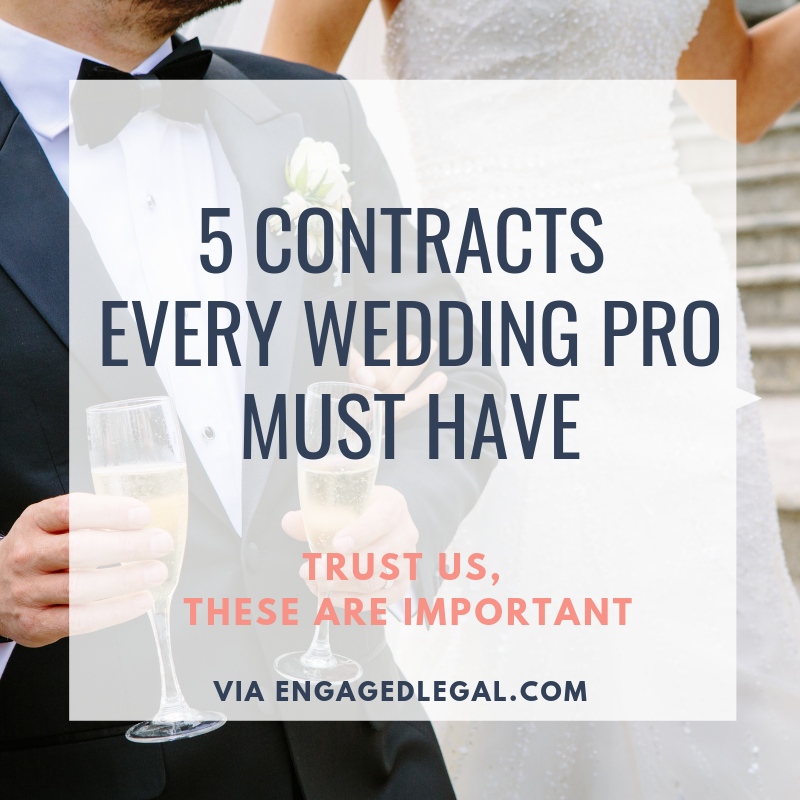Copyright Myths Wedding Pros NEED to Know
/Ohhh Copyright law. It can be so confusing. And to be fair, it changes all the time. 🙄
But from year to year, there are some “myths” that never fail to pop up over and over.
Don’t fall subject to the hype! Test out your knowledge and make sure you don’t accidentally commit copyright infringement by checking out the “myths and mythbusters” below:
Myth 1: “You can use someone’s photo/ image/ social post etc. if you give credit.”
Reality: Credit is not enough
People get in trouble for this a LOT.
I hear and see folks say they are “giving credit” to ensure you’re not committing copyright infringement. But guess what? That take is totally and completely incorrect.
“Giving credit” for using someone’s work does not mean you’re not committing copyright infringement. Giving credit does absolutely nothing to do with copyright infringement. It has nothing to do with getting out of a copyright infringement claim.
Honestly, the only thing it does is show that you know it’s not your image, any you know it belongs to that other person!
Now, do some licenses require the user to give credit? SURE! But that would be a licensed use of the image according to a contract between the copyright holder and the user. That would be set forth in either (i) a written document/ license agreement between you and the copyright holder, or (ii) the “terms of use” of a stock photography site like our friends at Sourced Co. or even the baked-in terms of a site like Unsplash.
There are actually groups and lawyers that specifically target unlicensed use of images on blogs and will come after you demanding $1500, $2500, or $4500. They operate on a mass scale, and utilize web technology to “crawl” websites across the internet. So be very, VERY careful and make sure your images are coming from a reputable source!
Myth 2: The “Poor Man’s Copyright”
A poor man’s copyright is when a person creates something, shoves it in an envelope/ box, and mails it to themselves. Because the item was mailed on a specific date, the theory is that a copyright is created as of that date for the underlying material that was mailed in an envelope. It’s considered an “almost free” way to get a copyright registration as opposed to filing with the copyright office.
Except…..This doesn’t work.
As detailed by the Copyright Office:
“The practice of sending a copy of your own work to yourself is sometimes called a ‘poor man’s copyright.’ There is no provision in the copyright law regarding any such type of protection, and it is not a substitute for registration.”
But hey, we love a creative approach to problem solving— I’ll give them that!Myth: “You can copy up to 10% of something before it’s copyright infringement”
Reality: Not true. Any copying can show infringement.You may have hear that you can use a copyrighted work “if you change three things,” or “if you make ten changes” or if “the work is changed 10%,” and so on. That’s bogus. If you copy something, there is no scientific, quantifiable number, percent, or degree of changes that can ensure you escape committing copyright infringement.
The standard is “substantially similar,” and it is based more on the importance of the piece of of the work that was copied. If the resulting work is “substantially similar” to the original work, it’s copyright infringement.
For example: If Shakespeare’s copyright in Romeo and Juliet had not expired before West Side Story was written, Shakespeare/ his estate could have sued the writers of that of West Side Story and likely would have won.
Myth: “I paid someone for my logo/ photos, so I own the copyright.”
Reality: Just because you paid for it does not mean you own it.Here’s a BIG one: Just because you pay a designer, an artist, or a writer to produce things like logos, designs, content, or copy does not mean you automatically own the copyright to that created work!
Let’s walk through this:
Upon creation, the copyright vests in the author of the photo/ logo/ design/ image/ song/ writing. So unless YOU made it yourself, with your own two hands, you're not the owner! Which means to use that particular work, you need a copyright assignment.
A “copyright assignment” is essentially a document that says “Contractor X created this design. They are now assigning all right, title, and interest in the creative work to Me, the Business Owner.” (Shameless plug: we have a copyright assignment, also called a “copyright transfer agreement,” in our digital downloads template shop)
There is an exception here for a "Work Made For Hire." This occurs when there is an employer/ employee relationship (read: NOT an independent contractor!) and the creative "thing" was made within the scope of the employee's work. As an example, a logo created by an in-house designer at a company would belong to the company. A logo created by someone hired on a project basis-- like an outside small agency, or an independent contractor-- wouldn't be a work made for hire (unless specific exceptions apply).
What other copyright myths have you heard?



















